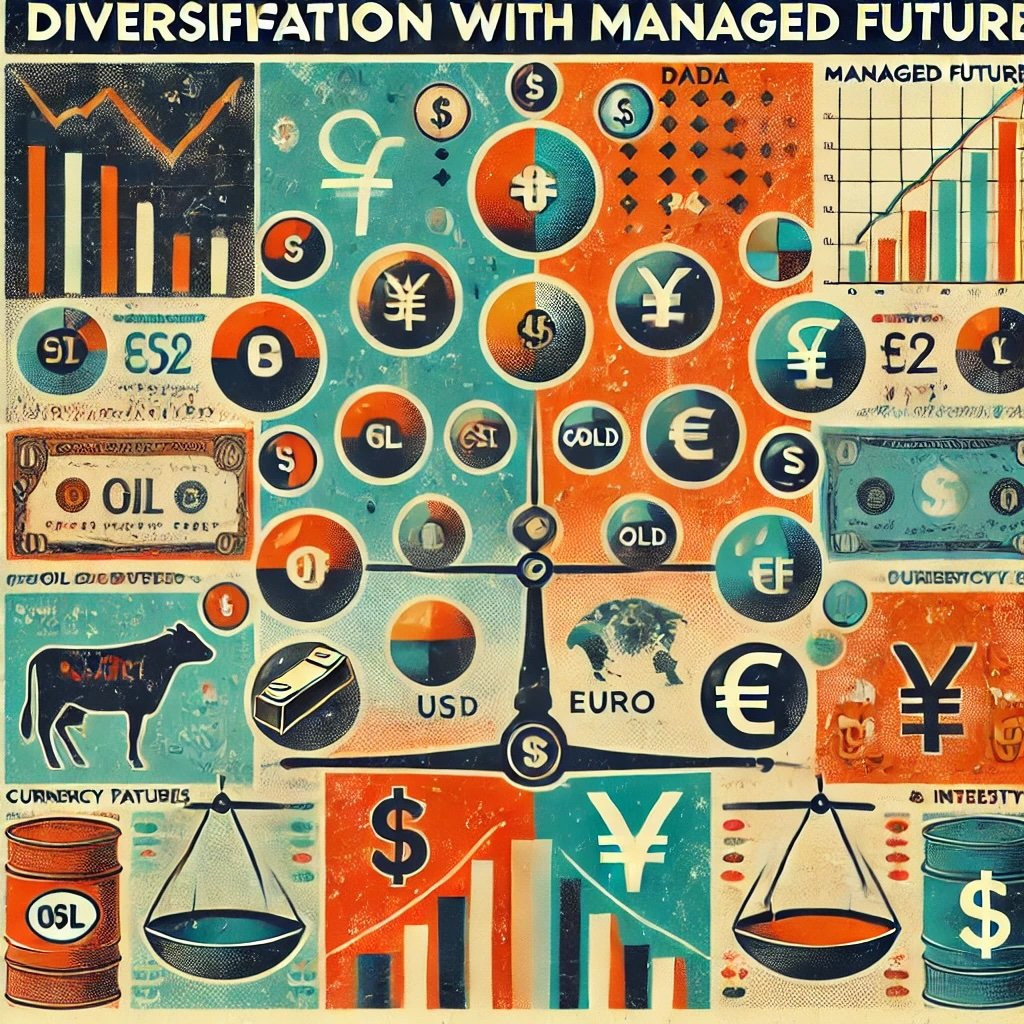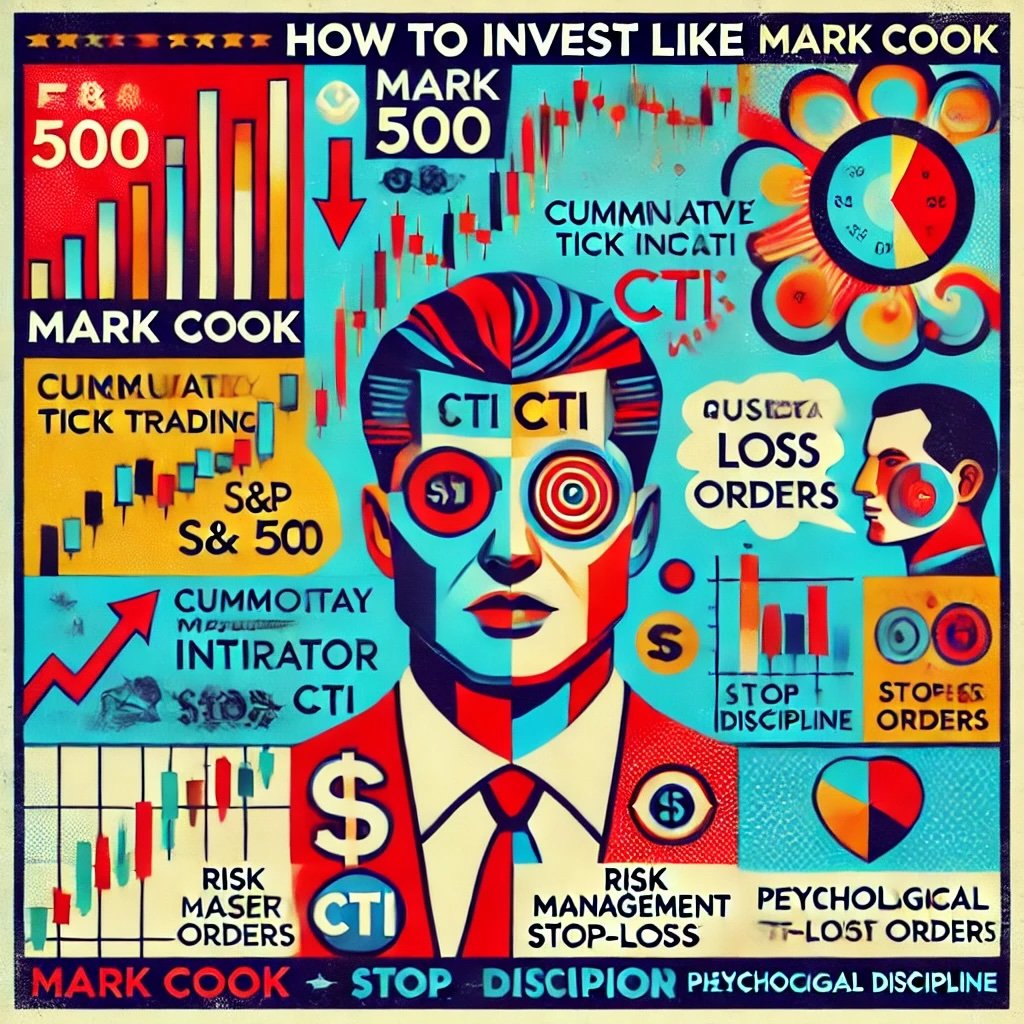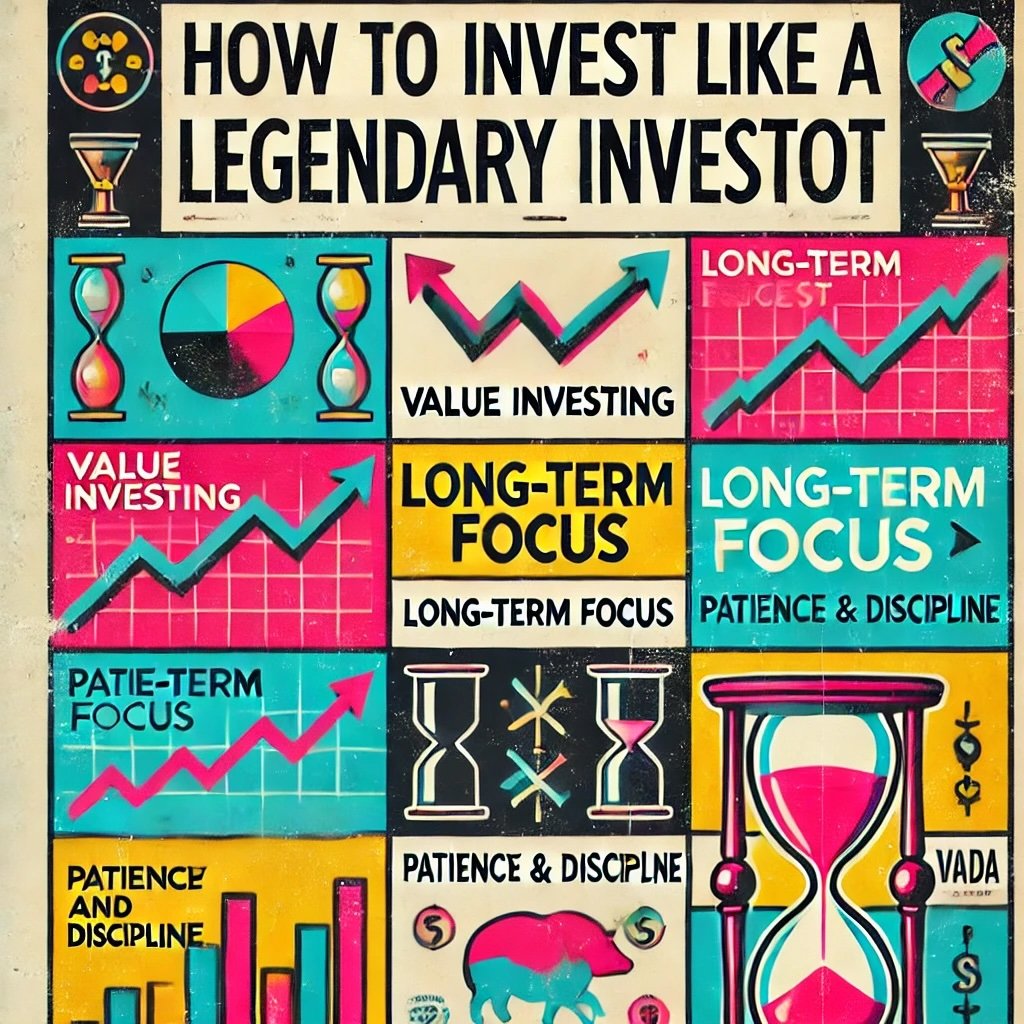Bear markets bring turbulence. They’re defined as periods when stock prices drop by 20% or more from recent highs, often creating a ripple effect across global markets. During these downturns, traditional portfolios that rely heavily on stocks and bonds tend to struggle.
source: WealthChannel on YouTube
Overview of Bear Markets and Their Impact
Stocks, which typically make up a large portion of a standard portfolio, can see prolonged declines. Bonds, often used as a counterbalance to equities, may offer some stability, yet they too can face challenges, particularly when interest rates rise. For investors, this means potential losses on multiple fronts.
In a bear market, even the most diversified stock and bond portfolios may fail to protect investors from significant drawdowns. High correlation between these asset classes under stress conditions only amplifies the struggle. This leaves many investors asking: where can they find true diversification that withstands a bear market’s unique challenges?

Introduction to Managed Futures
Enter managed futures. Managed futures are investment vehicles that allow professional managers to use futures contracts, options, and other financial derivatives to profit from both upward and downward market trends. Unlike traditional investments, managed futures funds often focus on commodities, currencies, interest rates, and other non-traditional assets, giving them a unique place in a well-rounded portfolio.
Managed futures have gained popularity for their potential to perform independently of traditional asset classes, especially in times of economic uncertainty. Their flexibility and adaptability make them particularly appealing as a hedge against market volatility and downturns. Managed futures managers can take long or short positions, meaning they can potentially profit regardless of whether prices are rising or falling.
- Definition: Managed futures allow for professional investment in commodities, currencies, and other non-traditional assets.
- Flexibility: Fund managers can take advantage of both upward and downward market movements.
- Appeal in Volatility: Their design is suited for performance in uncertain or negative market conditions.
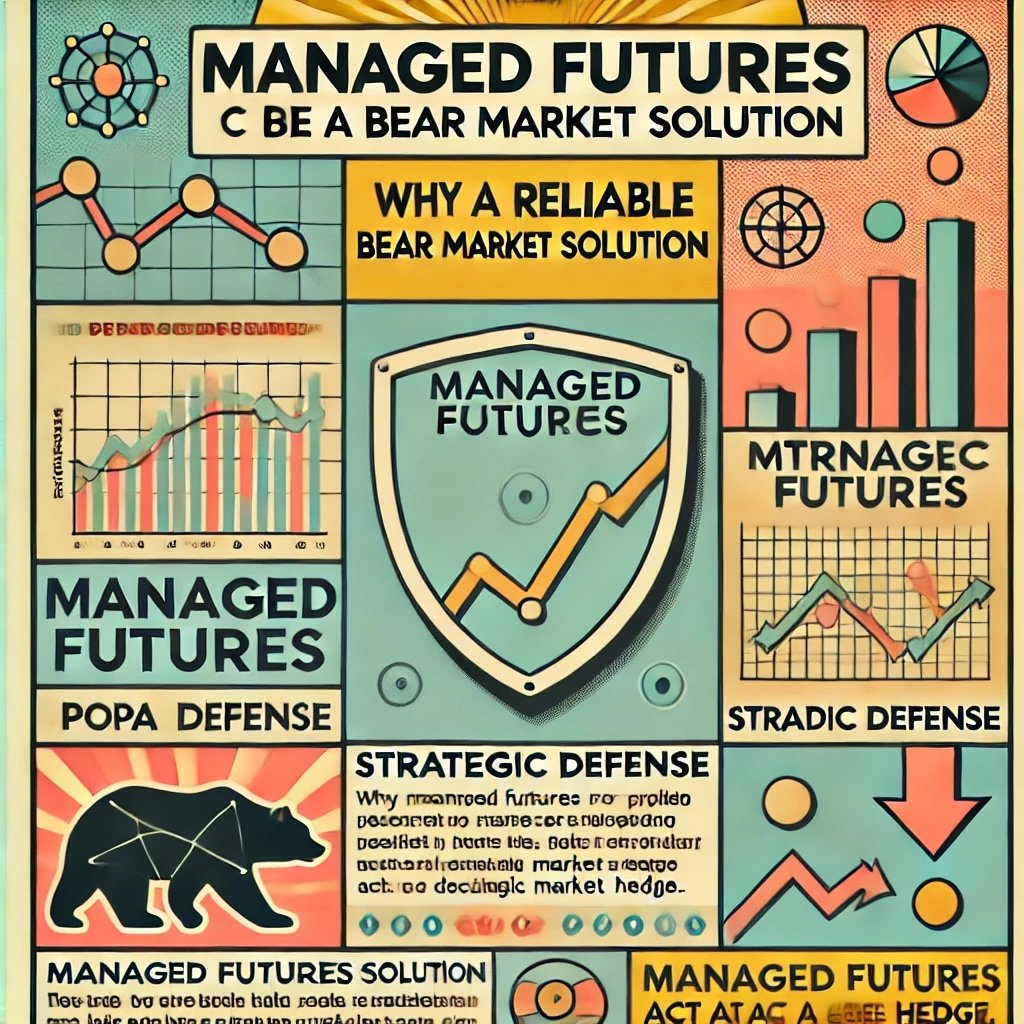
Why Managed Futures Could Be Your Bear Market Solution
The purpose of this article is simple: to show how managed futures offer a strategic defense in bear markets. When typical portfolios falter, managed futures have the potential to add a layer of resilience. They serve as a hedge against extreme volatility, cushioning against market declines and potentially minimizing portfolio drawdowns.
Managed futures aren’t just for high-net-worth individuals or institutional investors. Many funds are now accessible through ETFs and mutual funds, opening the door for everyday investors to benefit from this alternative strategy. Whether you’re looking for a long-term hedge or simply seeking a new way to stabilize your portfolio, managed futures offer a powerful tool to consider.
Tip: If you’re new to managed futures, start by understanding the basic mechanics of futures and options. They’re a different world from stocks and bonds but can provide unique advantages, especially in bear markets.
Managed futures are not a silver bullet, but they are a compelling option. For those prepared to explore alternative investments, they offer potential stability in the face of an unpredictable market. As we dive further, we’ll explore the specifics of managed futures, how they function, and how you can strategically integrate them to bolster your portfolio against the ups and downs of bear markets.
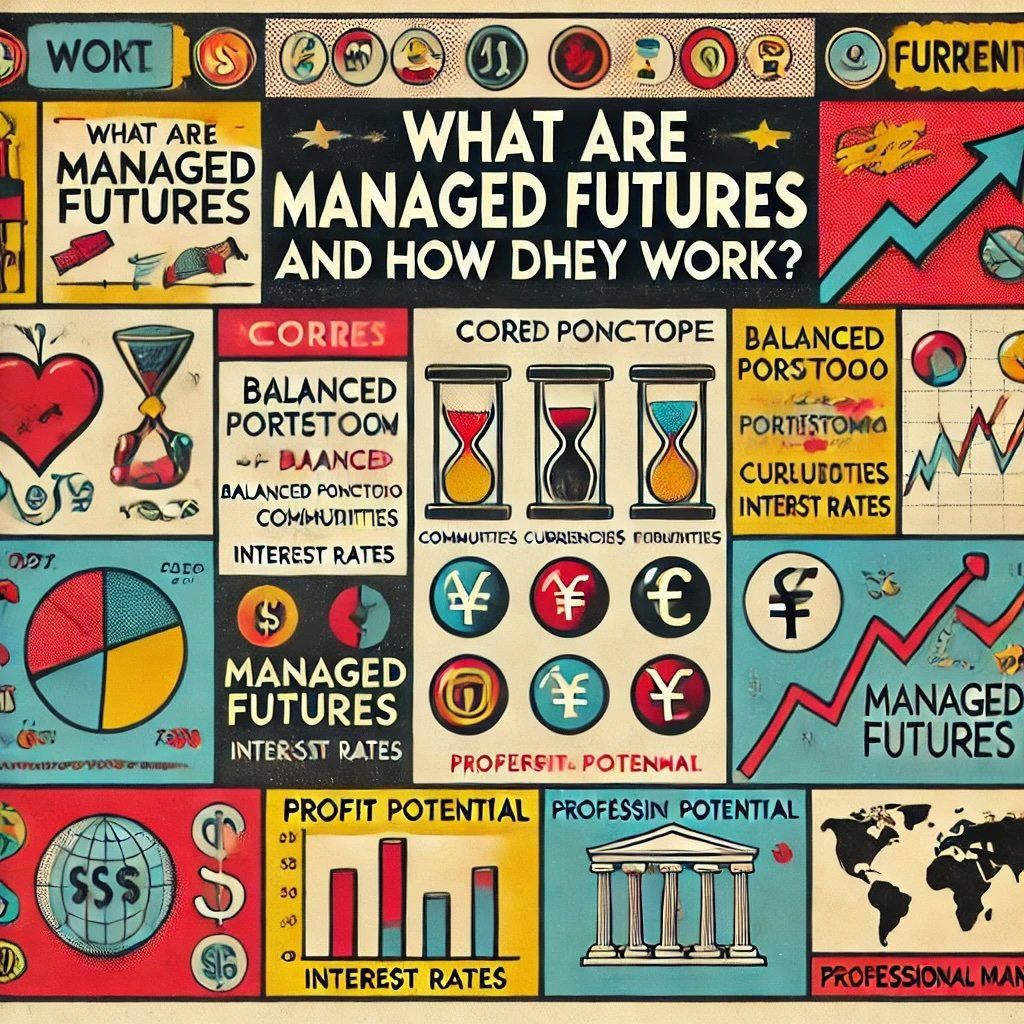
What Are Managed Futures and How Do They Work?
Core Concepts and Structure
Managed futures may sound complex, but the concept is simple: they’re investment strategies managed by professionals who use futures contracts, options, and other derivatives to profit from market movements. Unlike traditional funds focused solely on stocks or bonds, managed futures funds spread their reach to a broader set of assets, including commodities, currencies, and interest rates. This versatility allows them to potentially profit in various market conditions, whether prices are rising or falling.
The structure of managed futures involves a professional fund manager, often called a Commodity Trading Advisor (CTA). These experts use a mix of data analysis, market trends, and economic indicators to make informed decisions on buying or selling futures contracts. Futures, in particular, are agreements to buy or sell an asset at a future date and a set price, making them suitable for strategies aimed at capturing gains in both positive and negative market environments. Through this approach, managed futures become a flexible, adaptable investment strategy that responds quickly to changing conditions.
- Definition: Managed futures funds are professionally managed funds using futures and options across various assets.
- Professional Management: Managed by Commodity Trading Advisors (CTAs) who actively monitor and respond to market trends.
- Adaptability: These funds can go long or short, profiting in both up and down markets.
Diversification with Managed Futures
One of the standout features of managed futures is diversification. Unlike a typical equity-focused portfolio, managed futures often hold assets like commodities (oil, gold, agricultural products), currencies (USD, Euro), and interest rate contracts. Each of these asset types reacts differently to global economic shifts. For instance, when stocks drop, gold or other commodities may rise, helping managed futures funds offer a form of counterbalance to traditional investments.
Managed futures go beyond traditional diversification. By including assets with low or even negative correlation to the stock market, these funds can reduce portfolio volatility. This makes them particularly appealing during periods of market stress, as they tend to perform independently of stock and bond markets. A diversified portfolio can minimize risk, and managed futures add a valuable layer of protection when markets become unpredictable.
- Commodities: These include assets like oil and gold, often less correlated to stocks.
- Currencies: Managed futures can capitalize on fluctuations in global currencies.
- Interest Rates: Futures on interest rates add another dimension, especially when rates are volatile.
Tip: Managed futures provide a unique kind of diversification that doesn’t rely solely on traditional asset classes, helping investors create a portfolio that can withstand different types of market pressure.
How Managed Futures Enhance Portfolio Resilience
In a world where stocks and bonds tend to move together during crises, managed futures can offer a refreshing alternative. By adding these non-traditional assets, investors gain access to markets that don’t behave like equities. This asymmetrical behavior—moving in different directions from stocks—can help stabilize overall portfolio performance, especially in turbulent times. Managed futures funds have been known to outperform in bear markets, providing a cushion that supports long-term investment goals.
Managed futures aren’t a cure-all, but they’re a smart addition for investors looking to build resilience into their portfolios. Whether it’s the flexibility of trading futures contracts or the stability of diversified assets, these funds offer unique benefits. For those who are comfortable with the complexities of futures and options, managed futures provide a promising way to adapt to modern market challenges.
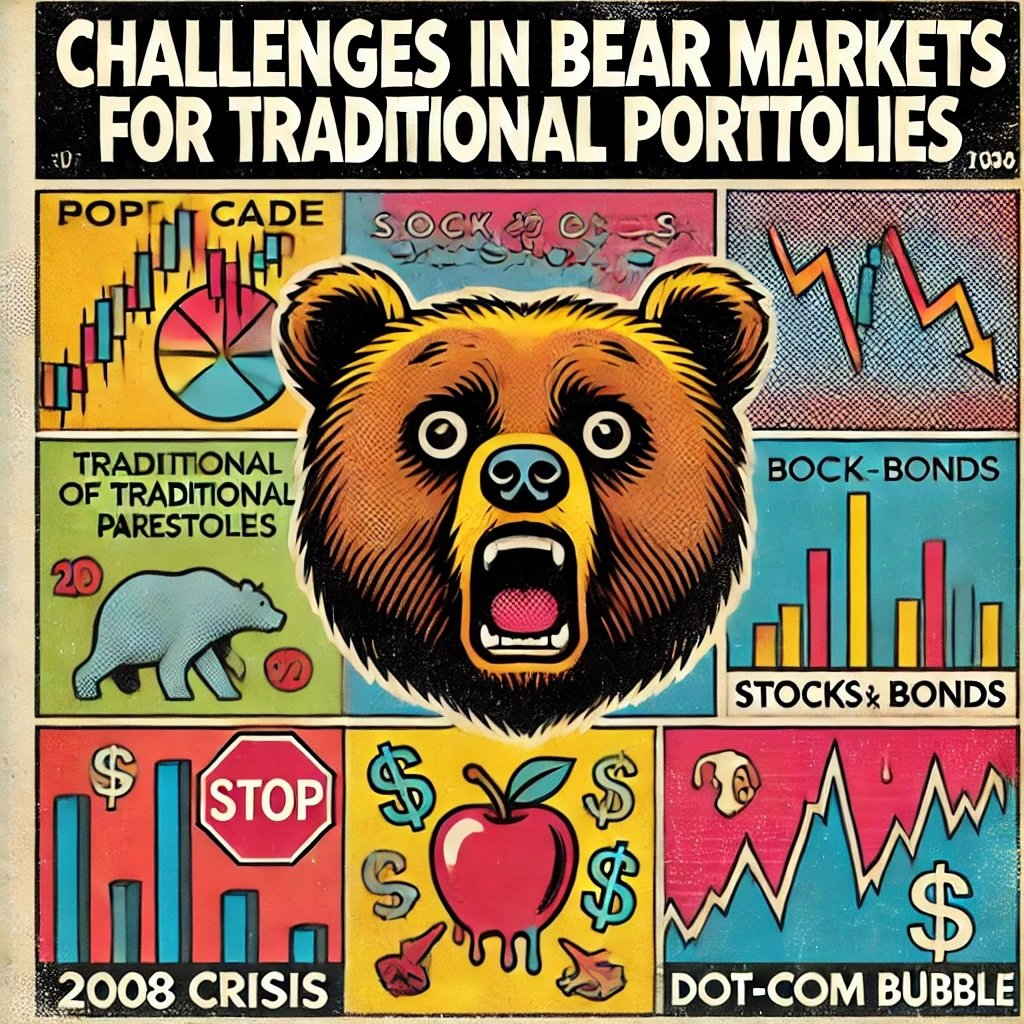
Challenges in Bear Markets for Traditional Portfolios
Understanding Bear Markets
Bear markets are periods where the prices of securities, primarily stocks, fall by 20% or more from recent highs. This prolonged downturn is typically driven by widespread pessimism and negative sentiment across financial markets. For example, the 2008 financial crisis and the dot-com bubble in 2000 led to severe bear markets, where stocks lost significant value over an extended time. In these environments, investors face unique challenges. Stocks, generally the backbone of many portfolios, lose value rapidly, leading to substantial portfolio drawdowns. Even bonds, usually considered a safe haven, may not hold up well depending on the nature of the downturn and interest rate environment.
Bear markets can be emotionally taxing. Investors may be tempted to sell their assets and move to cash, fearing further losses. Yet, these quick reactions often lead to missed recovery opportunities once markets eventually rebound. For traditional portfolios, the impact can be devastating, particularly when the primary assets—stocks and bonds—fail to provide the stability investors expect.
Why Traditional Portfolios Face High Correlation
In bear markets, a common phenomenon occurs: assets that typically have little correlation, such as stocks and bonds, start to move in the same direction—down. During times of economic stress, high correlation is often observed because market participants tend to act in similar ways, selling off assets to preserve cash. For example, in the 2008 financial crisis, investors witnessed steep declines across asset classes that were previously thought to offer diversification, from corporate bonds to real estate. This effect erodes the protective buffer that bonds or other assets might provide in more typical market conditions.
When stocks and bonds decline together, portfolios primarily composed of these assets suffer. Diversification becomes less effective, as there’s little offsetting of losses when everything moves in the same direction. The impact can be particularly challenging for investors with conservative or balanced portfolios who depend on bonds to mitigate stock market volatility. Unfortunately, the usual assumption that bonds will act as a counterbalance can break down in severe bear markets, leaving portfolios highly vulnerable.
- Increased Correlation: Economic downturns lead to similar behavior across asset classes, reducing diversification benefits.
- Impact on Bonds: Bonds may not serve as a reliable counterbalance in times of intense market stress.
- Vulnerability: Traditional stock and bond portfolios are more exposed to losses when correlations rise.
Tip: Understanding the correlation between assets in your portfolio can help you assess its resilience in bear markets. Keep an eye on economic indicators that could signal increased correlations, such as interest rate shifts or broad economic downturns.
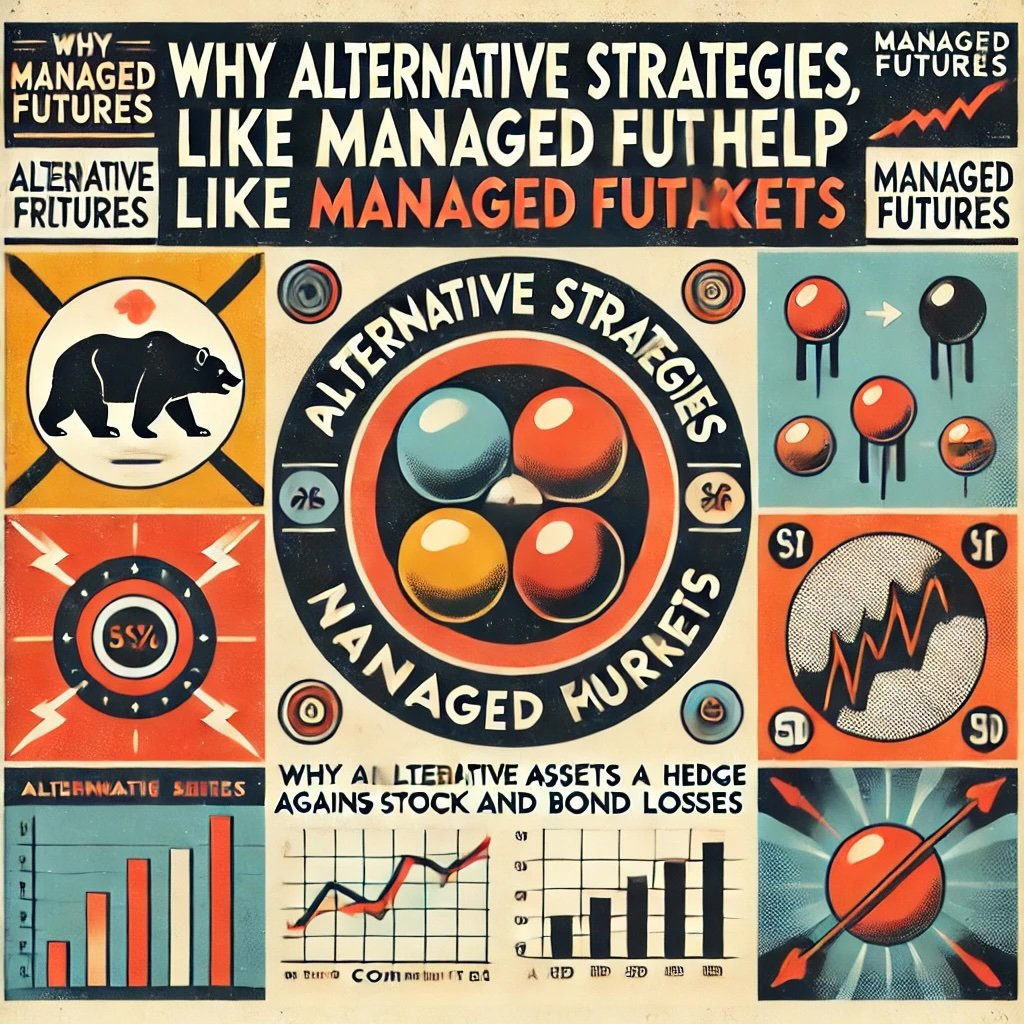
Why Alternative Strategies, Like Managed Futures, Can Help
For investors relying solely on stocks and bonds, the challenges of bear markets are clear. The high correlation across asset classes reduces diversification benefits, amplifying losses and making portfolio recovery a slow, difficult process. This is why some investors consider alternative strategies like managed futures. These strategies often involve assets and instruments that don’t follow the same patterns as traditional stocks and bonds, providing a much-needed hedge when markets take a turn for the worse.
Managed futures, with their ability to go both long and short, can adapt to market trends, offering potential relief in downturns. By reducing the portfolio’s reliance on stocks and bonds alone, investors can add an extra layer of defense. While managed futures come with their own risks, they’re often used to add balance to a portfolio that might otherwise be heavily impacted by bear markets.
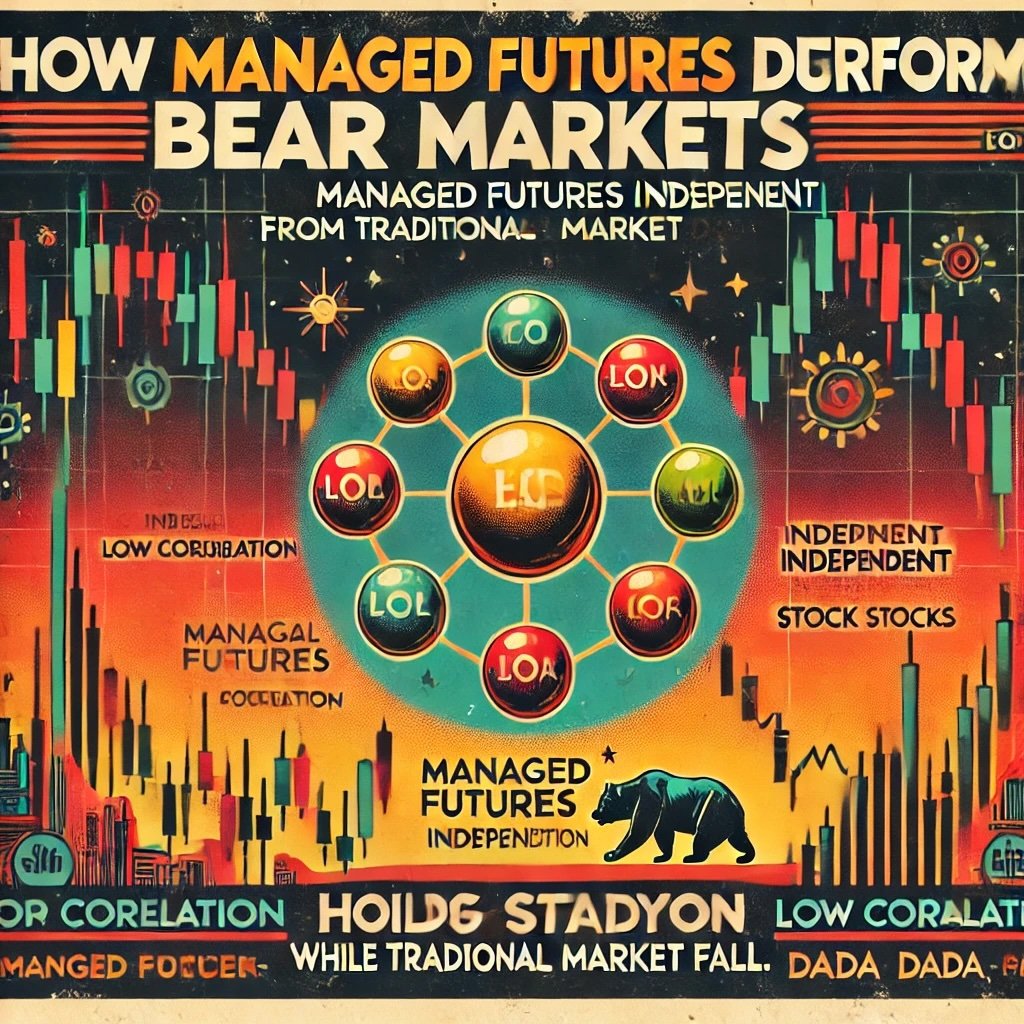
How Managed Futures Perform in Bear Markets
Benefits of Low Correlation
Managed futures have a key advantage that makes them particularly attractive during bear markets: low or negative correlation with stocks. This means that managed futures don’t necessarily follow the trends of traditional markets. When stocks are in a downward spiral, managed futures can still hold their ground—or even see gains—since they’re not tied to equity performance. Their structure allows for independent operation from stock and bond markets, offering a valuable buffer against broad market declines.
For investors, this low correlation brings essential diversification benefits. Traditional portfolios often struggle during downturns due to high correlation between asset classes. Managed futures, however, respond differently to economic signals, which can provide stability when other investments are under pressure. By incorporating managed futures, a portfolio becomes less vulnerable to the cascading effects of bear markets, helping maintain balance.
- Independent Movement: Managed futures don’t rely on stock performance and can thrive in bear markets.
- Portfolio Stability: Adding managed futures can help offset losses in traditional investments.
- Diversification: Low correlation with equities offers a defensive layer, crucial in bear market conditions.

Adaptability of Managed Futures
One of the standout features of managed futures is their adaptability. Unlike traditional assets, managed futures funds can go both long and short, meaning they’re designed to profit in either rising or falling markets. This flexibility enables fund managers to pivot based on market conditions. For example, if commodities like oil or gold show growth potential, managers can take long positions. Conversely, if they foresee declines in certain assets, they can go short, aiming to benefit from these price drops.
Historically, managed futures have performed well during major market downturns. For instance, in the 2008 financial crisis, managed futures were able to gain while global stock markets saw substantial losses. This adaptability is a defining feature, as managed futures funds adjust to market signals and shift their positions in real-time, seizing opportunities even in bleak economic conditions.
- Long and Short Positions: Managers can adjust strategies to capitalize on either market direction.
- Performance in Downturns: Managed futures have shown resilience in past bear markets, like in 2008.
- Dynamic Adjustments: Real-time adaptability allows managers to respond to economic shifts.
Value of Active Management
Active management is critical in managed futures funds. Unlike passive investment strategies, which hold assets through all market conditions, managed futures rely on professional managers who continuously monitor trends and make strategic decisions. These managers use tools like technical analysis, economic indicators, and market forecasts to inform their moves. As markets evolve, fund managers can shift asset allocations, increase or decrease positions, and adapt based on market sentiment or data.
This approach contrasts sharply with passive investments, such as index funds, which often stay static during downturns. Managed futures provide a hands-on strategy that actively mitigates risk in bear markets. By staying engaged, fund managers can shift tactics to preserve capital, something a passive approach simply can’t achieve. With managed futures, you’re not relying on the market’s overall direction but instead on the manager’s ability to interpret and react to it.
- Hands-On Management: Professional managers make real-time decisions to protect and grow capital.
- Active vs. Passive: Unlike passive funds, managed futures adjust continuously to market shifts.
- Preserving Capital: Active management allows for flexible, proactive responses to market challenges.
Tip: If you’re considering managed futures, look for funds with strong management teams. The success of managed futures often depends on the expertise and decision-making skills of the fund managers, so choosing a reputable team can make a significant difference.

Advantages and Limitations of Managed Futures as a Hedge
Key Benefits in a Bear Market
Managed futures have proven themselves as powerful tools for navigating the challenges of bear markets. One of their primary advantages lies in their ability to operate independently of stock market trends, which can make them particularly resilient during downturns. By diversifying a portfolio and adding managed futures, investors can help reduce the impact of sharp declines in traditional assets like stocks and bonds, effectively minimizing portfolio drawdowns. The adaptability of managed futures—through long and short positions—enables them to capture value across different market environments, regardless of overall direction.
In addition to drawdown protection, managed futures can also contribute to long-term portfolio resilience. Since these investments aren’t restricted by typical market constraints, they can add stability and balance over time. While the stock market may be in decline, managed futures have the potential to generate gains in other areas, supporting long-term returns even when other assets struggle. The liquidity of the futures market further enhances this benefit, allowing managers to adjust positions quickly. This high level of flexibility enables managed futures to respond to real-time market changes, taking advantage of opportunities and reducing risk more efficiently than less liquid assets.
- Drawdown Protection: Managed futures can lessen the impact of bear market downturns on portfolios.
- Resilience: They add long-term stability by providing non-correlated returns.
- Liquidity: Futures markets allow for fast adjustments to changing market conditions.
Tip: If you’re looking to reduce volatility and smooth out returns, adding managed futures could provide the diversification needed to counterbalance more traditional assets.
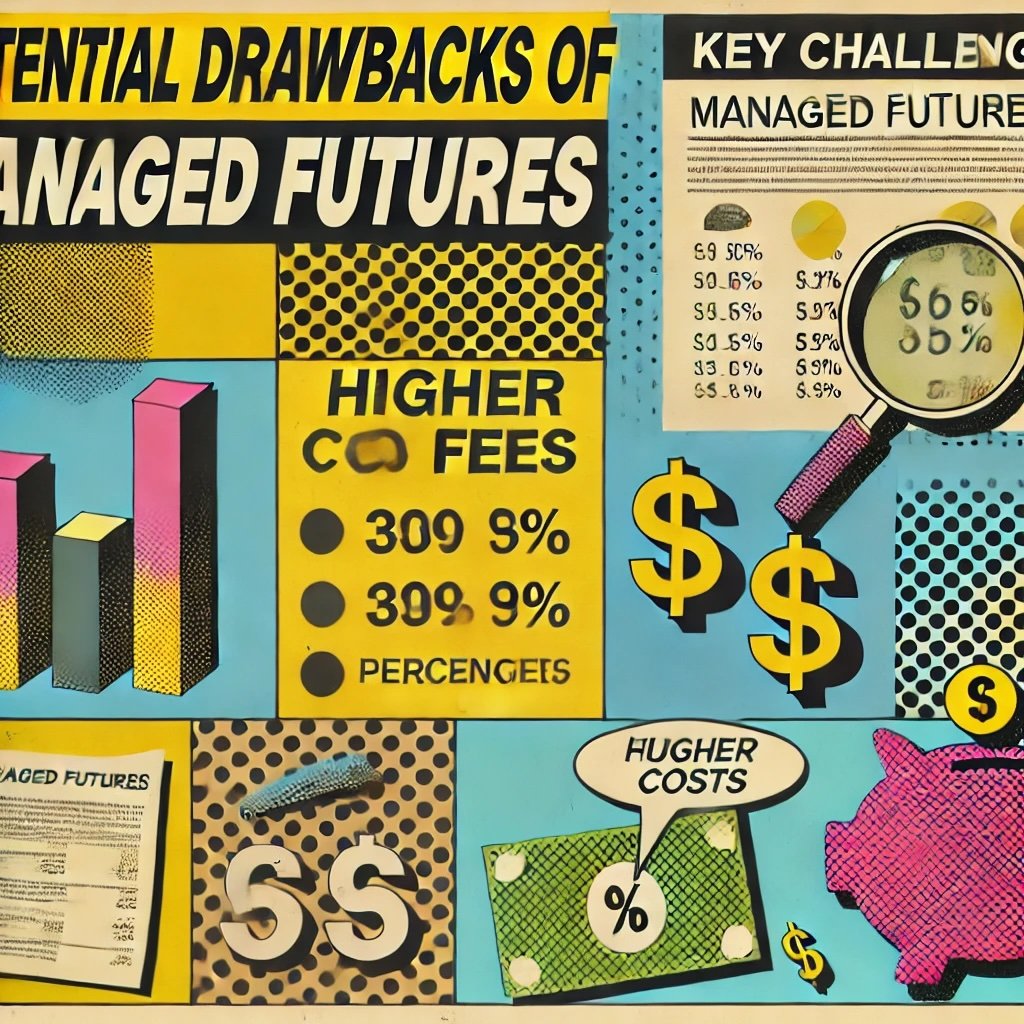
Potential Drawbacks
Despite their benefits, managed futures aren’t without their drawbacks. One of the primary concerns for many investors is the cost. Managed futures funds often carry higher fees due to active management and the specialized skills required for futures trading. Management fees, combined with performance fees, can eat into profits, especially during periods of lower returns. These fees may be justified by the expertise and strategic adaptability managed futures offer, but they are still a consideration for any investor weighing the costs and benefits.
Another potential downside is aligning managed futures with personal financial goals and risk tolerance. These investments are not for everyone. Managed futures can experience periods of high volatility, and their success relies heavily on the decisions of the fund manager. Investors who prefer a stable, predictable investment may find managed futures too dynamic or risky for their preferences. Furthermore, while managed futures are beneficial during market downturns, they may underperform during strong bull markets. This variability in performance makes them less suitable for investors with a short-term outlook or those uncomfortable with temporary dips in value.
- Higher Fees: Management and performance fees can be a significant cost.
- Volatility: Managed futures may be too volatile for risk-averse investors.
- Performance Variability: They may underperform in bull markets compared to traditional assets.
Tip: Consider managed futures if your investment strategy aligns with their benefits, but stay mindful of potential costs and volatility. Ensuring these characteristics match your risk tolerance and financial goals is crucial.
Balancing the Pros and Cons
Managed futures can offer a defensive strategy for those looking to add stability during turbulent markets. Their ability to act as a hedge in bear markets is valuable, particularly when traditional assets like stocks and bonds struggle. However, they’re not without their limitations. Fees, volatility, and performance variability make them better suited for investors with a long-term perspective who are comfortable with more complex strategies.

Why Managed Futures Might Be the Bear Market Solution You Need: 12-Question FAQ
What are managed futures, in plain English?
Managed futures are professionally run strategies that trade futures (and sometimes options) on commodities, stock indices, government bonds, and currencies. Because they can go long or short, they’re built to seek returns in both rising and falling markets—making them a potential shock-absorber when stocks slide.
Why do they tend to help specifically in bear markets?
Many managed-futures programs use rules-based trend following. When downtrends take hold in equities, managers can short stock index futures and go long safe-haven or falling-rate exposures elsewhere (e.g., bonds, certain currencies, commodities), creating negative or low correlation to stocks right when you need it most.
Can they really reduce portfolio drawdowns?
They can. By adding a return stream that often diverges from stocks and sometimes bonds during stress, a managed-futures sleeve may lower peak-to-trough losses and speed up recovery after big sell-offs—especially useful when stocks and bonds fall together.
How do they decide what to buy or short?
Most funds follow systematic signals (breakouts, moving averages, momentum) with risk controls (volatility targeting, stop losses). The process is rules-driven, not gut-feel, which helps keep decisions disciplined during panic.
Will they always make money when stocks are down?
No. In whipsaw markets (fast reversals, no clean trends), systems can get chopped up. Think of them as crisis-diversifiers, not iron-clad crash insurance. Over full cycles, the aim is to win big in trends and lose small when noise dominates.
How much should an investor allocate?
Common ranges are 5–20% of a diversified portfolio. A pragmatic start is ~10%, funded pro-rata from stocks and bonds. Higher allocations may suit investors who prioritize drawdown control and diversification over maximizing bull-market upside.
Through what vehicles can I access them?
Liquid funds/ETFs (’40-Act/UCITS/ETF): daily liquidity, simpler ops, lower mins.
Limited partnerships/managed accounts: institutional features, more strategy breadth.
Check fees, liquidity, and leverage policy for fit.
What are the main trade-offs and risks?
Whipsaw risk: choppy tapes can dent returns.
Fee drag: management + performance fees vary; understand total cost.
Expectation risk: returns won’t mirror any single crisis; programs differ in speed, markets traded, and risk.
What should I evaluate before picking a fund?
Process clarity: pure trend vs multi-strategy; time horizons.
Risk stats: max drawdown, recovery time, MAR/Sharpe, downside months.
Correlation behavior: to equities/bonds in stress windows.
Costs & capacity: total expense, slippage controls.
Operational quality: team, risk governance, transparency.
How do I integrate and rebalance in a bear market?
Set a target weight (e.g., 10%) with bands (±20% of the sleeve). If equities fall and the sleeve rises, trim back to target; if equities rebound and the sleeve lags, add back. The discipline preserves diversification and avoids timing errors.
Any tax or account-placement considerations?
Futures often have distinct tax treatment (jurisdiction-dependent) and can distribute short-term gains. When possible, hold in tax-advantaged accounts; in taxable, weigh after-fee, after-tax expectations and fund turnover.
What’s a simple action plan to get started?
Decide your objective (drawdown control vs return boost).
Pick a target allocation (5–20%).
Screen 3–5 funds/ETFs, compare process, costs, and stress-period behavior.
Fund gradually (e.g., 3 tranches over 6–12 weeks).
Establish rebalance rules and review quarterly.
Implementing Managed Futures in Your Portfolio
Investment Options for Managed Futures
When it comes to adding managed futures to your portfolio, there are several options to consider. Mutual funds, ETFs, and private managed futures funds each offer unique benefits and challenges. Mutual funds and ETFs, for instance, can provide broad exposure to managed futures while offering liquidity and ease of access. These vehicles are also regulated, which can provide an added layer of security for investors. ETFs may be particularly attractive for those looking to avoid high fees, as they typically have lower expense ratios than private funds.
Private managed futures funds, on the other hand, are often structured as limited partnerships and may come with higher fees due to specialized management. These funds can offer a more tailored investment approach with active management strategies that adapt to real-time market changes. However, they are usually available only to accredited investors and might come with minimum investment requirements, making them less accessible to smaller investors.
When selecting a managed futures product, it’s essential to evaluate strategy, performance history, and fee structure. Strategies can vary widely; some funds focus on commodities, while others may prioritize currencies or interest rate futures. Reviewing performance history gives insight into how a fund reacts in different market conditions, especially during downturns. Fees, while sometimes justifiable due to active management, should also align with the potential return and fit within your overall budget.
- Mutual Funds & ETFs: Easier access, lower fees, and regulated structures.
- Private Funds: Higher fees, customized strategies, and often only available to accredited investors.
- Key Factors: Evaluate strategy focus, performance history, and fee structure to find the best fit.
Tip: Before choosing a managed futures product, compare several options to ensure you’re selecting one that aligns with your investment goals and budget.
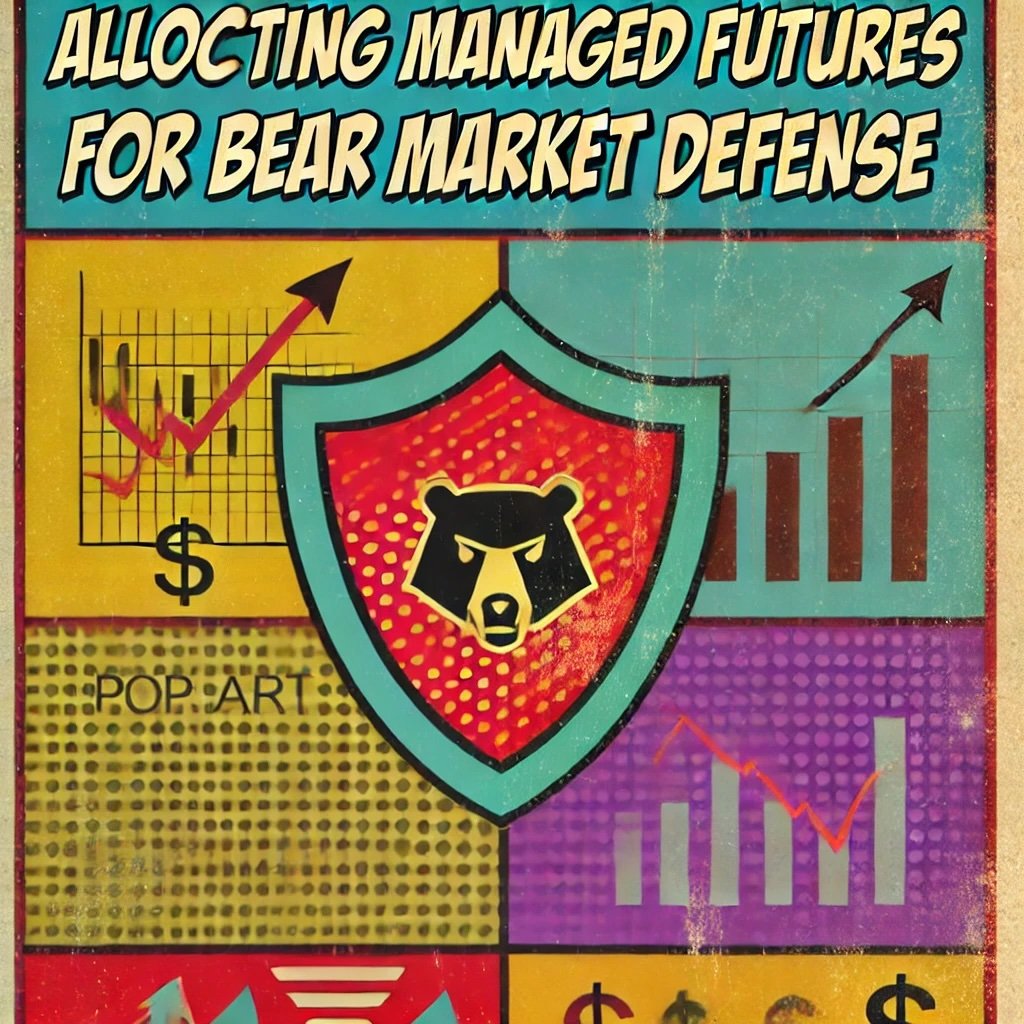
Allocating Managed Futures for Bear Market Defense
Allocating managed futures within a portfolio isn’t a one-size-fits-all decision. The ideal allocation depends on factors like risk tolerance, investment goals, and time horizon. As a general guideline, allocating between 5% and 15% of your portfolio to managed futures can add a layer of diversification and help defend against market downturns. However, for more aggressive investors or those highly concerned about bear markets, a slightly higher allocation could be considered.
Managed futures are particularly valuable for providing stability in volatile environments, so assessing your overall portfolio goals is crucial. For example, if you’re heavily invested in equities and want to offset potential losses, a higher allocation to managed futures could offer a counterbalance. On the other hand, if you’re already heavily diversified across various asset classes, a smaller allocation may suffice to achieve the added stability you’re seeking.
Consulting with a financial advisor is highly recommended when integrating managed futures into your portfolio. Advisors can provide personalized guidance on how to balance these investments with your broader financial strategy. They can also help navigate the complexities of managed futures, including selecting the right product and determining the optimal allocation to meet your goals.
- Suggested Allocation: Typically, 5%-15% of the portfolio, adjusted based on risk tolerance.
- Purpose: Adds stability and diversification, especially valuable in volatile markets.
- Advisor Insight: Financial advisors can help tailor the allocation to your individual needs and goals.
Tip: Revisit your allocation periodically, especially in response to market shifts, to ensure your managed futures position continues to support your broader strategy.
Making Managed Futures Work for You
Implementing managed futures can be a smart move, especially for investors seeking a hedge against market downturns. The variety of investment vehicles—mutual funds, ETFs, and private funds—gives investors flexibility in finding a product that meets their needs. By carefully selecting and allocating managed futures, you can position your portfolio for resilience in bear markets while taking advantage of the diversification benefits they bring. And with the help of a financial advisor, you can ensure that managed futures work as a strategic piece of your overall investment puzzle, supporting long-term growth and stability.
Important Information
Comprehensive Investment Disclaimer:
All content provided on this website (including but not limited to portfolio ideas, fund analyses, investment strategies, commentary on market conditions, and discussions regarding leverage) is strictly for educational, informational, and illustrative purposes only. The information does not constitute financial, investment, tax, accounting, or legal advice. Opinions, strategies, and ideas presented herein represent personal perspectives, are based on independent research and publicly available information, and do not necessarily reflect the views or official positions of any third-party organizations, institutions, or affiliates.
Investing in financial markets inherently carries substantial risks, including but not limited to market volatility, economic uncertainties, geopolitical developments, and liquidity risks. You must be fully aware that there is always the potential for partial or total loss of your principal investment. Additionally, the use of leverage or leveraged financial products significantly increases risk exposure by amplifying both potential gains and potential losses, and thus is not appropriate or advisable for all investors. Using leverage may result in losing more than your initial invested capital, incurring margin calls, experiencing substantial interest costs, or suffering severe financial distress.
Past performance indicators, including historical data, backtesting results, and hypothetical scenarios, should never be viewed as guarantees or reliable predictions of future performance. Any examples provided are purely hypothetical and intended only for illustration purposes. Performance benchmarks, such as market indexes mentioned on this site, are theoretical and are not directly investable. While diligent efforts are made to provide accurate and current information, “Picture Perfect Portfolios” does not warrant, represent, or guarantee the accuracy, completeness, or timeliness of any information provided. Errors, inaccuracies, or outdated information may exist.
Users of this website are strongly encouraged to independently verify all information, conduct comprehensive research and due diligence, and engage with qualified financial, investment, tax, or legal professionals before making any investment or financial decisions. The responsibility for making informed investment decisions rests entirely with the individual. “Picture Perfect Portfolios” explicitly disclaims all liability for any direct, indirect, incidental, special, consequential, or other losses or damages incurred, financial or otherwise, arising out of reliance upon, or use of, any content or information presented on this website.
By accessing, reading, and utilizing the content on this website, you expressly acknowledge, understand, accept, and agree to abide by these terms and conditions. Please consult the full and detailed disclaimer available elsewhere on this website for further clarification and additional important disclosures. Read the complete disclaimer here.

